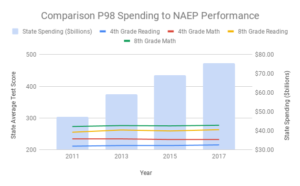To keep Bill Clinton’s 1992 presidential campaign on message, campaign strategist James Carville hung a sign in Clinton’s Little Rock campaign headquarters that read “It’s the economy, stupid.” The country was in recession then and Carville knew a Clinton victory depended on keeping voters focused on that subject. Clinton won.
Every California state legislator should hang a sign in their office reading “It’s K-12, stupid,” though not because it’ll help them win but because it’ll help their constituents win. K-12 is the largest General Fund expenditure and governed by the Education Code that’s written by you and the governor. It serves six million kids — and very poorly. Despite a 60 percent increase in Proposition 98 spending since 2011, K-12 performance in California has barely changed, according to the National Assessment of Educational Performance:

An extra $28 billion per year of spending didn’t make a difference. That’s not a surprising outcome to anyone who knows where the money went (substantially to increases in spending on unfunded pensions and insurance subsidies for retirees on Medicare) and how schools are required to be managed under the Education Code (not for the benefit of customers; ie, students). That’s not the only troublesome measure. Despite the increase in spending, class sizes aren’t shrinking and teachers in Los Angeles, Oakland and Sacramento have gone on strike because so little of that extra money is going to them.
Schools shouldn’t be robbing young teachers to subsidize the insurance of retirees covered by Medicare and they should be run like every other enterprise patronized by Californians, including yourselves, which means for the benefit of customers. That means management must be able to pay more to employees who take on tougher tasks, pay for performance, terminate underperforming employees, and not be required by law to offer lifetime employment or to lay off employees in reverse seniority. You can make all those fixes.
It’s worth noting that Carville’s sign included another line: “Change vs. more of the same.” More of the same is not working for K-12’s six million customers.

